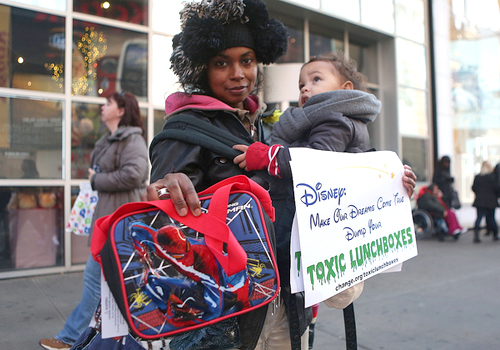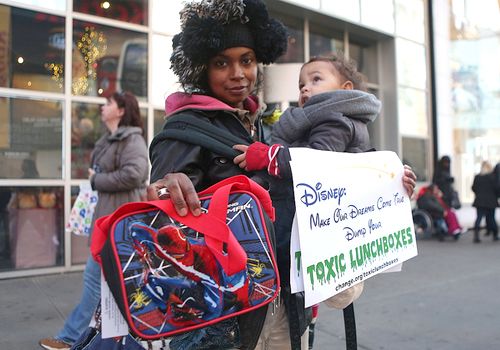

Center for Health, Environment & Justice
By Mike Schade
Last Saturday, I stood outside of Disney’s iconic flagship store in Times Square, calling on them to make our dreams come true, by getting poisonous phthalates and vinyl plastic out of children’s school supplies.
I organized the action with Penelope Jagessar Chaffer, a mother of two young children (who also came along for the fun), and director of the fantastic new environmental health documentary, Toxic Baby.
With me and Penelope and other concerned NYC residents were the voices and dreams of more than 65,000 parents and Disney customers, who had signed petitions calling on the company to do what’s right for our children’s health.
Hidden Hazards in Disney School Supplies
It all started with our recent report on toxic school supplies, that I researched and authored this past summer. Our investigation found Disney branded school supplies, like Disney Princess lunchboxes and Spiderman backpacks, loaded with hormone disrupting phthalates, toxic chemicals linked to asthma and early puberty that are getting into our children’s bodies.
The levels of Disney school supplies were off the charts, up to thirty times higher than what’s legal for toys. We couldn’t believe it!
The report led to massive press coverage across the country and inspired Lori Alper, a mother of three school-aged boys from Bedford, Massachusetts, to launch a petition on Change.org calling on Disney to eliminate these harmful chemicals. MomsRising.org joined in the campaign and also posted the petition on their site.
Since launching the petition, Change.org and MomsRising.org together have mobilized more than 65,000 parents to call on Disney to make our dreams come true and get these dangerous substances out of our lunchboxes and backpacks once and for all.
Unfortunately, Disney has ignored these protests and calls, so we knew we had to ramp up the pressure.
Dreaming of a toxic-free Disney in Times Square
So last Saturday, braving the cold NYC weather, we bundled up with our box full of petitions to deliver them to Disney’s flagship store in NYC’s Times Square.
We passed out flyers to customers walking in and out of the store, as well as tourists that were strolling by. Many were shocked to discover Disney sells school supplies laced with chemicals that have been linked to asthma, birth defects and ADHD.
We held signs that read, “Disney: Make Our Dreams Come True—Dump Your Toxic Lunchboxes.” After educating hundreds of tourists and customers, we walked into the store, asked to speak to the store manager, and attempted to deliver our box full of petitions, along with this letter. The store manager unfortunately refused our petitions, directing us to talk to the corporate headquarters, but that was OK. We knew our message had been delivered.
As we were delivering our petitions in NYC, hundreds of miles away, Lori Alper and the Alliance for a Healthy Tomorrow were doing the very same at a Disney store outside of Boston, which you can read about in this great post by Lori.
In conjunction with these actions, we and our allies at MomsRising.org also launched a social media campaign calling on Disney to address our concerns. The response to this has been amazing. Within only a few days of launching this campaign, it’s been shared by more than 1,600 people across the country.
Help us keep up the momentum!
Today is of course “Cyber Monday”—so join us online in calling on Disney to make our dreams come true—by sharing this post with your friends on Facebook and Twitter today.
——–
This post originally appeared on CHEJ’s Backyard Talk blog.

 233k
233k  41k
41k  Subscribe
Subscribe 
